Greetings from Portugal. What follows is the first in a series of entries in my attempt at a travel journal. Over the next two weeks, Daydreams & Paving Stones will be bringing you nonsense from Lisbon, Sintra and Cascais, Seville, up the devastated eastern coast of Spain, and finally from the streets of Barcelona. History. Architecture. Clean public toilets. For now, though, take a glimpse into my jet-lagged brain as I try to cobble my impressions of Porto into something coherent.
Also, I am obliged to let you know that I am writing these while on my honeymoon. I got married a month ago. My wife and I are traveling through the Iberian Peninsula as a way to celebrate our love before attempting to build a life in the gathering hell of the United States.
To reiterate, I am sacrificing sections of what may be one of the few moments of unadulterated beauty and joy my wife and I will be getting in the imminent future in order to provide you with a brief moment of entertainment. You’re welcome. Now subscribe, and pay me if you haven’t already.
I.
“Grant me, O fishes, clear instruction, lest I forget this lesson on the second stage of my journey into Portugal: may I learn in passing from one land to the next to pay the closest attention to the similarities and differences, whilst not forgetting something in common to both humans and fishes alike, namely that a traveller has preferences and sympathies unconstrained by the obligations of universal love, never hitherto required of him. To you, then, I at length bid farewell, O fishes, until a future day: may you follow your own course out of the sight of fishermen. Swim joyfully on, and wish me a safe journey. Farewell, farewell.” – Jose Saramago, Discovering Portugal
Jose Saramago was a magnificent writer, as close to a titan of 20th century literature as Portugal ever produced, but his Discovering Portugal is a perplexing work. Not because it is difficult per se, but because it isn’t difficult. There isn’t much in the way of heft or knotty language to grapple with. Rather, it presents itself as a fairly aimless and meandering travelogue. It’s difficult to find anything to grab onto.
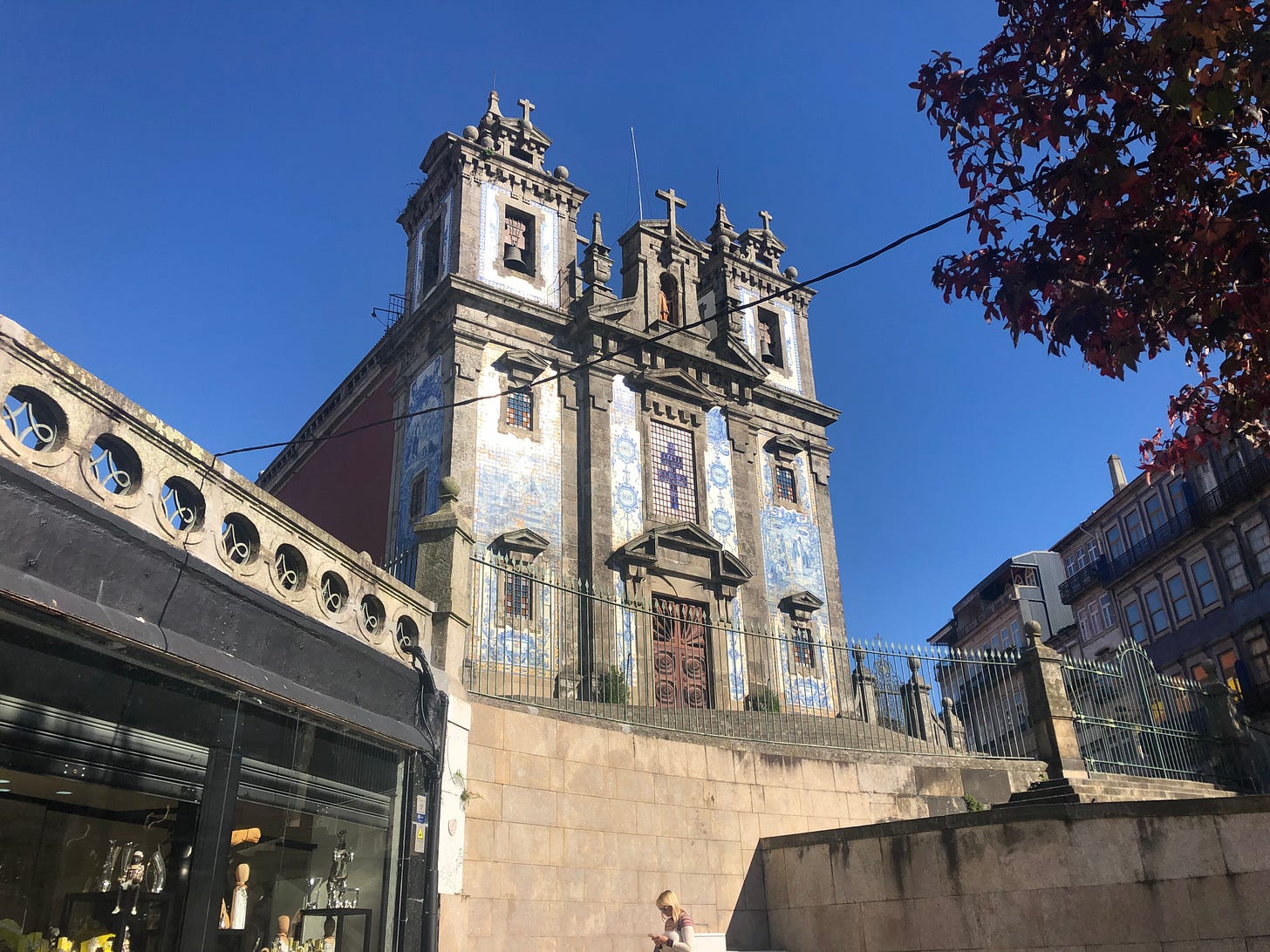
Or at least it is for the outsider. For while the tiny churches and old homes and villages he encounters rarely show up in a typical tourist guide, he isn’t writing for tourists. Saramago always treated the thorny with a sense of play. He also, as a committed communist, deeply loved his country. This did not make him a patriot, though he did sometimes use the word. But all the chest-thumping chauvinism that tends to come with patriotism is very much anathema to Saramago’s love of Portugal.
Perhaps it’s the result of living his first fifty years under autocratic rule, the way this pushes someone to find a kinder and more just mode of living in the cracks of a harsh reality. In any event, Saramago wrote Discovering Portugal for the Portuguese. The text is full of conversations with villagers, fishermen, farmers. People who, even if mentions of this or that church didn’t bring a specific image to mind, would still somehow know, intrinsically, what he’s writing about.
It is also full of strange interactions with demons, ghosts, Satan himself, and a humble school of fish. A long time ago, we believed that places could tell us things without words. Then the Enlightenment came and fouled it all up, and ever since people like Saramago have been trying to rediscover these numinous ways of seeing and listening.
II.
The first section of Saramago’s book takes place in the north. But it takes him over a hundred pages to get to Porto, the largest in the region, and Portugal’s second city. There is a huge amount of history here: eight hundred year-old cathedrals and stone fortresses and modernist bridges spanning the river.
Urban geographers love to talk about the past and present colliding in the contemporary cityscape. In Porto, it is unmistakable. One of the first things you notice upon entering this city is that, emerging from the tight cracks between slick storefronts and stone apartment-buildings covered with lichens is the sheer amount of construction that always seems to be happening. Cranes towering over the Old World skyline. Massive pits of dust and lime plunging into the cobblestone streets.
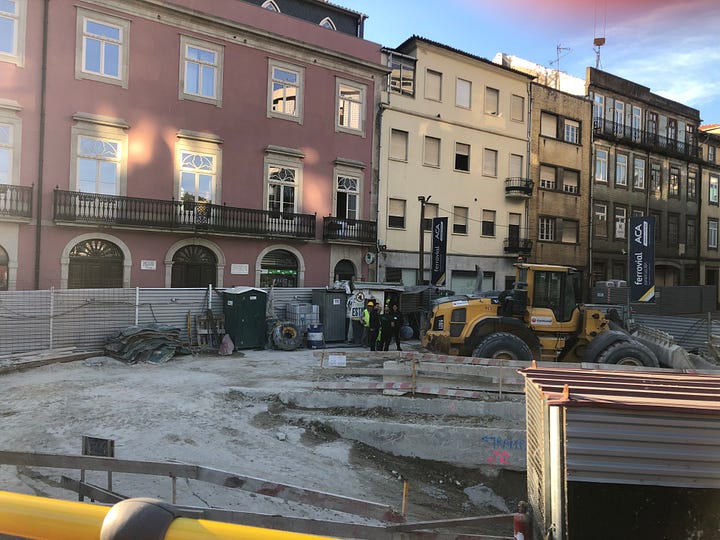
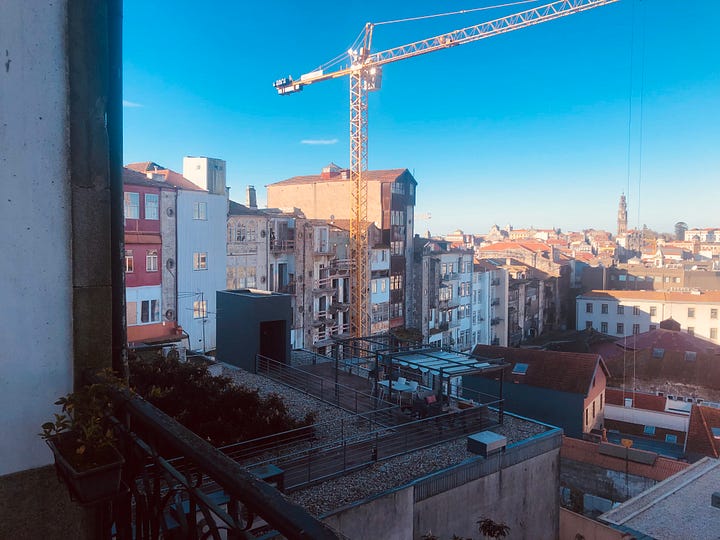
Much of this is for the expansion of Porto’s Metro system. It’s a good thing, as allowing a city’s citizens a communal form of travel can only be. But it moves at a snail’s pace, as each construction dig inevitably uncovers some previously unknown set of ruins. A Roman aqueduct. A Visigothic settlement. Construction halts. Archeologists descend. No word on when progress gets to restart.
The rest of the construction seems to come from a familiar adversary: developers. A lot of hay is made out of the respect shown for the 200-year-old building facades as the interiors are spruced up. But there is an unanswered question. Who, exactly, is all this development for?
All over Porto, there are flyers and stickers demanding more affordable housing. And there is undoubtedly a housing crisis in this city, much as its centrist mayor will equivocate over it. Like most other European cities, Porto has seen its tourism boom in recent decades. Its strange, unique architectural interweavings of past and present swarmed by gawking, dead-eyed foreigners. I’m one of them.
Most travelers of the left-wing or progressive bent would love to believe we are somehow different, more considerate of the locals and the preservation of the places in which they live. We aren’t. We can’t be. Nobody lives at the places that draw the most tourism, but more and more, cities’ whole economies are being bent around these sites. They make locals’ lives more expensive, more inconvenient, more alienating. Those of us who flock to visit them can’t reverse what’s been done to roll out the red carpet for us. Most of us are hypocrites.
This doesn’t make us all that unique, or even uniquely annoying. Most everyone, at one time or another, is a guest in someone else’s home, trying and likely failing to show deference and respect. It’s not like we asked them to punch a giant hole in their street before we came over. If everyone is a hypocrite, maybe our standards for hypocrisy are a bit skewed?
III.
I’ve been thinking a lot lately about the feeling of futurelessness. I’m not exactly alone in this regard. Mark Fisher seems to have popularized these considerations among the English-speaking left, but really they’ve been bouncing around our cultures since at least the fall of the Berlin Wall.
Before coming to Portugal, I spent a week in London at the Historical Materialism conference, which is exactly where weird obsessives like me come to obsess over these questions alongside others just like us so we can, for a weekend, not feel so insane in our obsessions. One of the more standout papers I listened to came from Phoebe Braithwaite (whose work you may know from The New Statesman, Wired, or Tribune) on the thought of Caribbean radical thinker Sylvia Wynter and — wait for it — the wisdom of frogs. Turns out there’s a lot that frogs, with their almost zen-like presentism and view from below, can tell us about searching for an opening toward liberation.
Having recently read Saramago’s words, I naturally thought of these ideas’ proximity to the fishes’ sermon. The act of going someplace new isn’t just, as cliche will tell us, to experience being a fish out of water. It is to see everything “from below,” half or wholly submerged beneath layers of misunderstanding, trying to find some way to communicate across these layers but ultimately unable to be heard as anything other than gurgling gibberish.
All the ideological faff of the tourism industry is dedicated to cutting against this reality. It can only do so much. One of the bests thing about Porto, what I truly loved about the city, was its ability to cut through all the static of tourism, to hope against hope for some kind of communication to be discovered. To see like a fish.
IV.
Freed by fish-vision, Mrs. Daydream and I spent our first day in Porto drifting through the city on a big tourist bus. The double-decker kind without a roof. They hand you headphones you are to plug into a small console on your seat to hear a polite voice tell you a few random facts about passing landmarks.
The headphones were old, and so was the recording. It was fuzzy and had a tone of resignation to it. The person who recorded these tidbit factoids was either roped into it by their boss or crestfallen that all the work they had put into their voiceover career had led them here. Often you couldn’t even make out what they were saying about the landmarks. The gaggle of tourists riding the top level with us would crane our necks and gawp desperately, trying to catch the statue or church we were being described before it disappeared entirely from view. Just in the nick of time we would realize that we were meant to be staring at a church facade that was under construction, hidden behind scaffolding and tarpaulins.
It was fine. If you know a few things about the history of Portugal, its conquests and religious fanaticisms and modernist dalliances, then you may get something out of of having the basics of the Batalha or the Casa da Musica or Forte de São João Baptista da Foz.
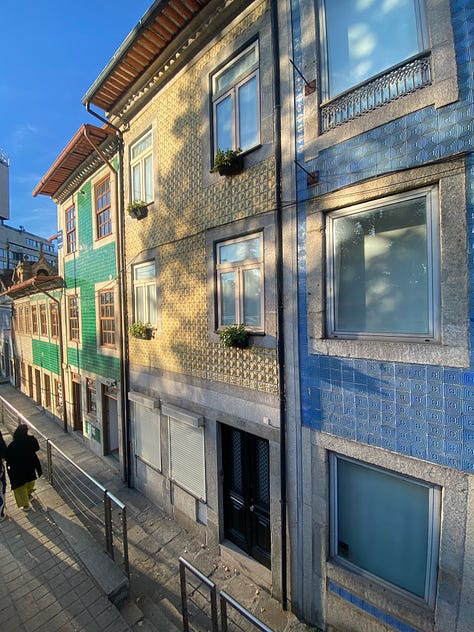
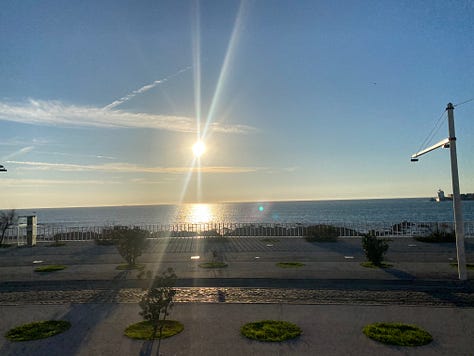
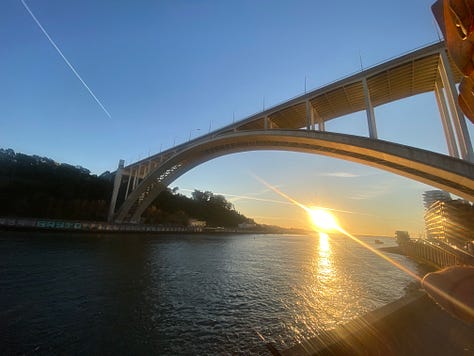
What you won’t get is the story of the young and depressed fisherman who left the Batalha with his prayers unanswered, the skaters who use the slopes the Casa courtyard to do tricks on, the drunken student who swore he saw the ghost of São João Baptista da Foz skulking the grounds of the fort.
V.
The place we stayed was on Santa Catarina Street. It is a wide road, is traffic tightly controlled and open to pedestrians, sloping down then up, peppered with restaurants, hotels, stores. Most are aimed in the direction of what will attract tourists to Porto, which means projecting an idea of Porto that most residents wouldn’t fully recognize. Or if they do, it would be in that uncanny valley kind of way. The hotels are comfortable and bland. The restaurants, like Cafe Majestic, have that generic Old World charm to them, their fades and scratches around the edges painstakingly places.
The shops are perhaps the most egregious. Zara. Benetton. Levi’s. H&M. Retailers you can find in just about any city in Europe, Asia, or the Americas. Certainly nothing specifically “Portuguese” about them.
There were also buskers, local musicians who astutely recognized there was a bit of coin to make off tourists. Most were guitarist-singers, wailing third-rate folk rock or acoustic emo. Truly something you can hear anywhere else, and not worth stopping for.
The fourth or fifth busker we encountered was a young violinist. He mostly played contemporary pop redone for his instrument. Then he played “Bella Ciao.”
Maybe he played it because he’s a fan of Casa de Papel. Maybe he played it because he thought all the tourists would recognize it. I would like to believe that, in a country which is now celebrating fifty years since the fall of its dictatorship, which now faces — like most European countries — an insurgent far-right, there was a bit more intent behind playing an Italian partisan anthem. It’s likely many of us wouldn’t get it, but he wasn’t playing it for us.
All photos by Kelsey Goldberg and the author.





